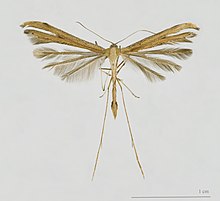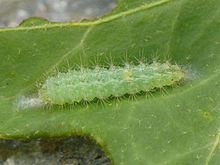Emmelina monodactyla
| Emmelina monodactyla | |
|---|---|

| |

| |
| Scientific classification | |
| Domain: | Eukaryota |
| Kingdom: | Animalia |
| Phylum: | Arthropoda |
| Class: | Insecta |
| Order: | Lepidoptera |
| Family: | Pterophoridae |
| Genus: | Emmelina |
| Species: | E. monodactyla
|
| Binomial name | |
| Emmelina monodactyla | |
| Synonyms | |
|
List
| |
Emmelina monodactyla (T-moth or morning-glory plume moth) is a moth of the family Pterophoridae. It is found in Europe, Japan, central Asia, North Africa and North America.
Description
The wingspan is 18–27 mm. The moths fly nearly year-round.[1]
The larvae mainly feed on Convolvulaceae species, including Calystegia sepium, Calystegia spithamaea, Calystegia soldanella, Convolvulus arvensis, Convolvulus cantabrica, Convolvulus floridus, Convolvulus prostratus, Convolvulus tricolor, Ipomoea batatas, Ipomoea eriocarpa and Ipomoea purpurea, and also Atriplex (including Atriplex patula) and Chenopodium (including Chenopodium album) from the family Amaranthaceae, Cynara cardunculus from the family Asteraceae, and Datura stramonium and Hyoscyamus niger from the family Solanaceae.[2]
The moths are pale russet in colour, with a wingspan of 18–27 millimeters. The colouration is extremely variable, ranging from off-white with indistinct markings to a strong rust brown. The markings may vary considerably in size. The second and third abdominal segments are elongate. The caterpillars are greenish-yellow with a broad green band on the back, and a narrow broken yellow line running down the center. Some specimens may also have a wine-red marking on the back. The colour of the pupae may range from green to reddish brown, sometimes with black markings.
-
Emmelina and pupae
-
Adult at rest
-
Caterpillar
References
- ^ Kimber, Ian. "Common Plume Emmelina monodactyla (Linnaeus, 1758)". UKmoths. Retrieved 23 August 2020.
- ^ Kim, Sora; Byun, Bong-Kyu; Park, Kyu-Tek; Lee, Seunghwan (2010-05-24). "Taxonomic study of the tribe Oidaematophorini (Lepidoptera: Pterophoridae) from Korea, with descriptions of the two new species". Journal of Natural History. 44 (23–24): 1377–1399. doi:10.1080/00222931003679006.
External links



